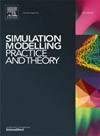三维gpu并行CDEM的开发与应用
IF 3.5
2区 计算机科学
Q2 COMPUTER SCIENCE, INTERDISCIPLINARY APPLICATIONS
引用次数: 0
摘要
该研究开发了一个三维、gpu并行的连续-非连续单元法(CDEM)程序,利用gpu上的CUDA C/ c++编程模型来模拟岩石变形、破裂和运动。本文首先概述了三维图形处理单元(GPU)并行化CDEM的理论和算法,重点介绍了并行化和优化。性能测试表明,3D gpu并行CDEM的计算速度比单核串行CDEM代码快645.31倍,显著提高了计算效率。通过花岗岩单孔爆破模拟,验证了岩石破裂的模拟结果。花岗岩的材料参数采用三维巴西和单轴压缩试验校准。与实验数据的对比表明,模拟结果能有效地再现观察到的裂纹形态。然而,应力波衰减存在差异,裂缝密度在不同截面上存在显著误差,这可能归因于加载方法的不同。结果表明,该模型能够模拟爆炸致裂的全过程,计算效率显著提高。然而,进一步提高准确性是必要的。这些发现强调了3D gpu并行CDEM在提高计算速度方面的优势及其在岩土工程中的潜力,特别是在模拟准静态和爆炸动态条件下的岩石裂缝方面。本文章由计算机程序翻译,如有差异,请以英文原文为准。
Development and application of a 3D GPU-parallelized CDEM for blasting induced rock fractures
The study has developed a three-dimensional, GPU-parallelized Continuum-Discontinuum Element Method (CDEM) program, utilizing the CUDA C/C++ programming model on GPUs to simulate rock deformation, fracturing, and movement. Initially, the paper outlines the theory and algorithms of the 3D Graphics Processing Units (GPU) - parallelized CDEM, focusing particularly on parallelization and optimization. Performance tests indicate that the 3D GPU-parallelized CDEM achieves a computational speed 645.31 times faster than a single-core serial CDEM code, significantly boosting computational efficiency. The simulation results of rock fracturing were demonstrated through a single-borehole blasting simulation in granite. Material parameters for granite were calibrated using 3D Brazilian and uniaxial compression tests. Comparisons with experimental data demonstrated that the simulation effectively replicated the observed crack patterns. However, discrepancies were noted in stress wave attenuation, and significant errors in crack density were observed across different sections, which may be attributed to variations in loading methods. These comparisons indicate that the proposed model can simulate the entire process of explosive-induced fracturing with substantial improvements in computational efficiency. Nonetheless, further enhancements in accuracy are necessary. These findings underscore the advantages of the 3D GPU-parallelized CDEM in enhancing computational speeds and its potential in geotechnical engineering, especially for simulating rock fractures under quasi-static and explosive dynamic conditions.
求助全文
通过发布文献求助,成功后即可免费获取论文全文。
去求助
来源期刊

Simulation Modelling Practice and Theory
工程技术-计算机:跨学科应用
CiteScore
9.80
自引率
4.80%
发文量
142
审稿时长
21 days
期刊介绍:
The journal Simulation Modelling Practice and Theory provides a forum for original, high-quality papers dealing with any aspect of systems simulation and modelling.
The journal aims at being a reference and a powerful tool to all those professionally active and/or interested in the methods and applications of simulation. Submitted papers will be peer reviewed and must significantly contribute to modelling and simulation in general or use modelling and simulation in application areas.
Paper submission is solicited on:
• theoretical aspects of modelling and simulation including formal modelling, model-checking, random number generators, sensitivity analysis, variance reduction techniques, experimental design, meta-modelling, methods and algorithms for validation and verification, selection and comparison procedures etc.;
• methodology and application of modelling and simulation in any area, including computer systems, networks, real-time and embedded systems, mobile and intelligent agents, manufacturing and transportation systems, management, engineering, biomedical engineering, economics, ecology and environment, education, transaction handling, etc.;
• simulation languages and environments including those, specific to distributed computing, grid computing, high performance computers or computer networks, etc.;
• distributed and real-time simulation, simulation interoperability;
• tools for high performance computing simulation, including dedicated architectures and parallel computing.
 求助内容:
求助内容: 应助结果提醒方式:
应助结果提醒方式:


